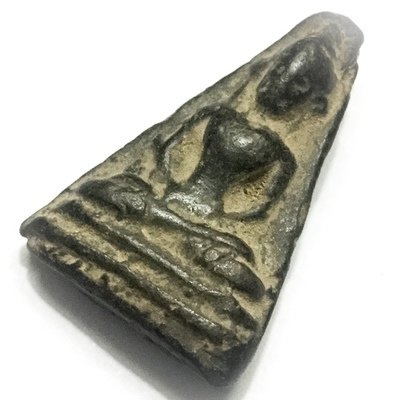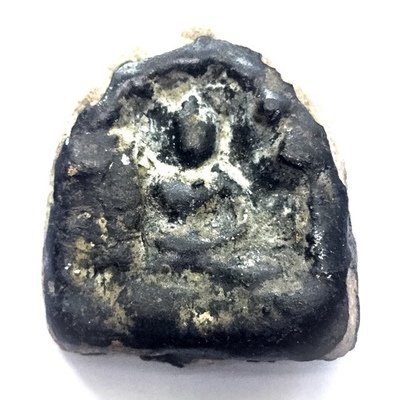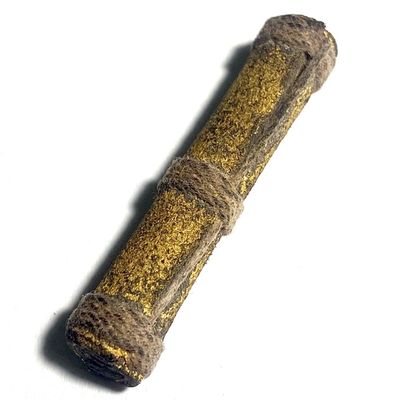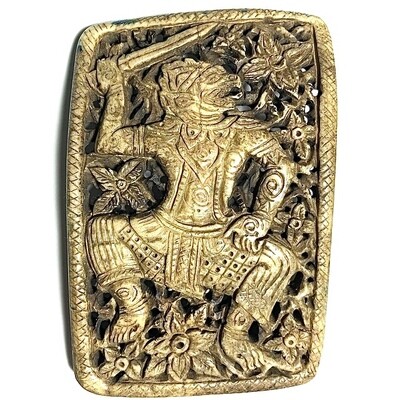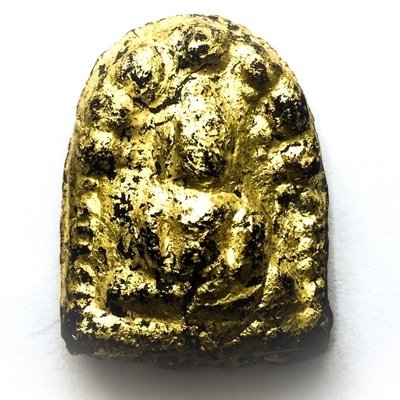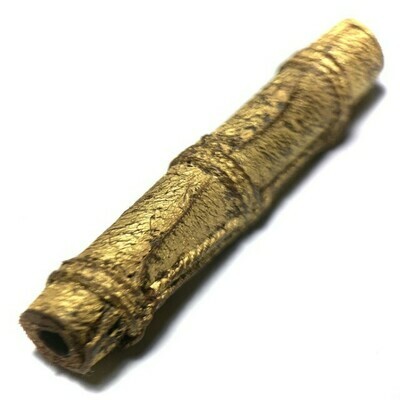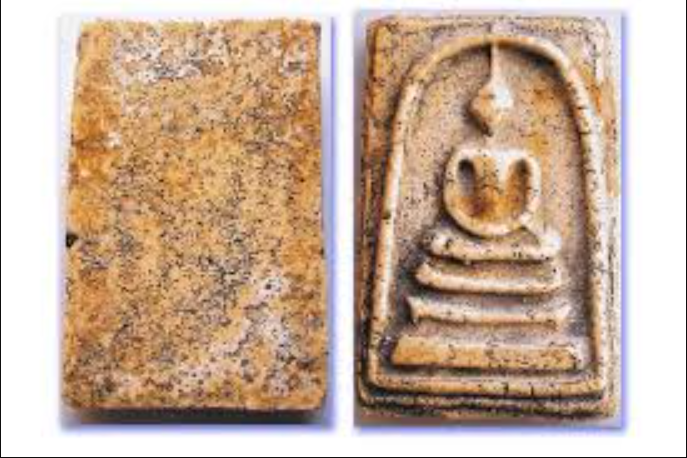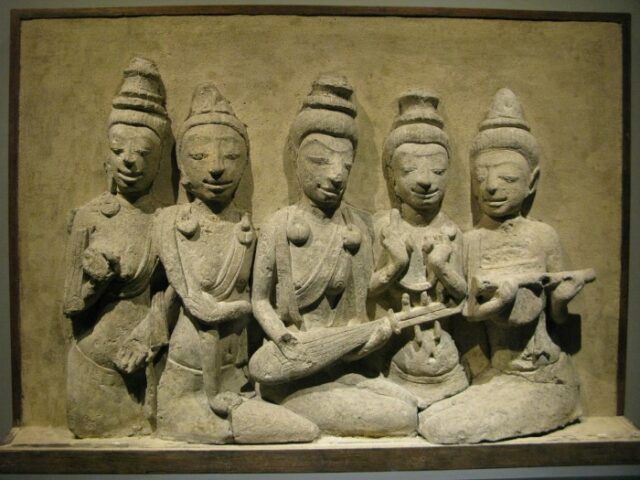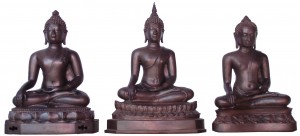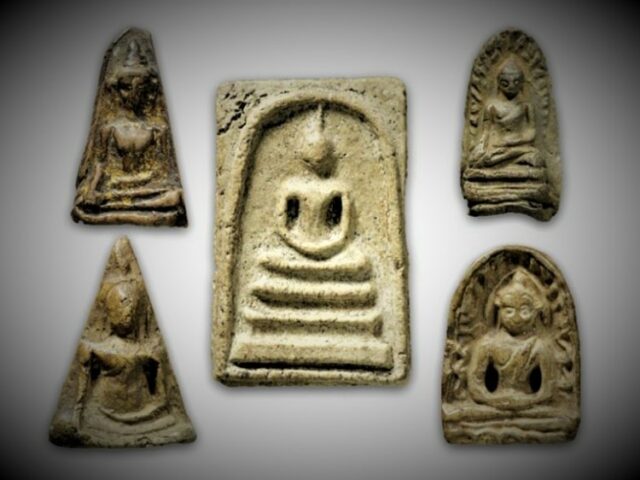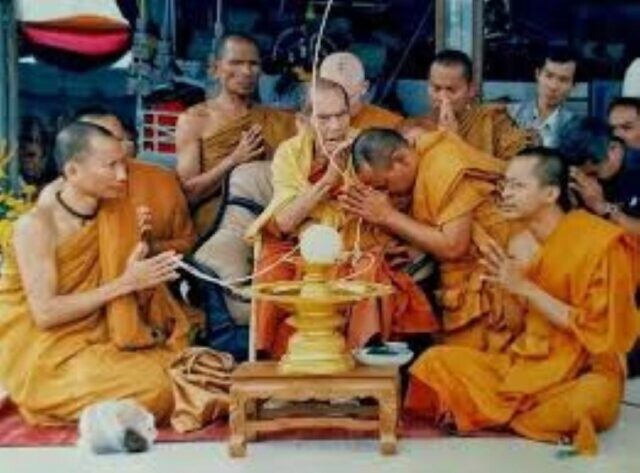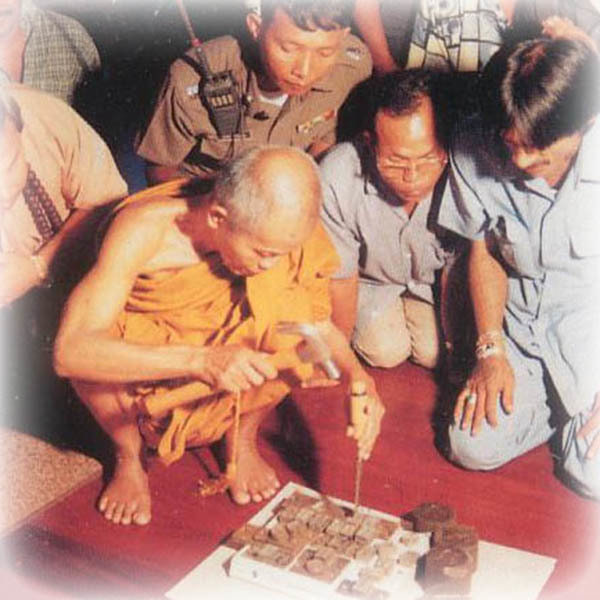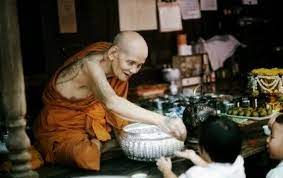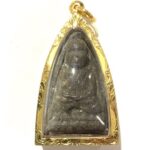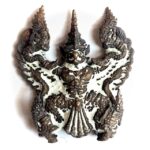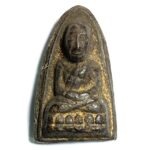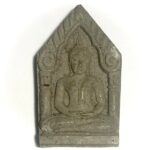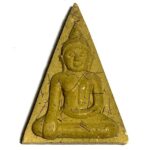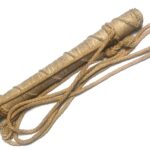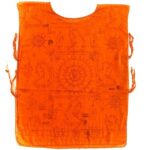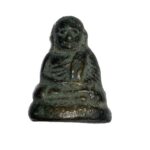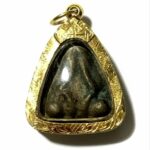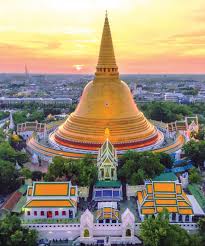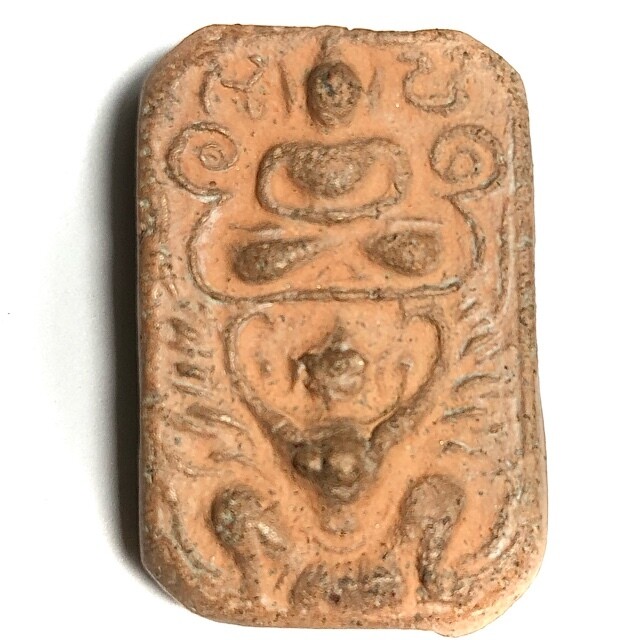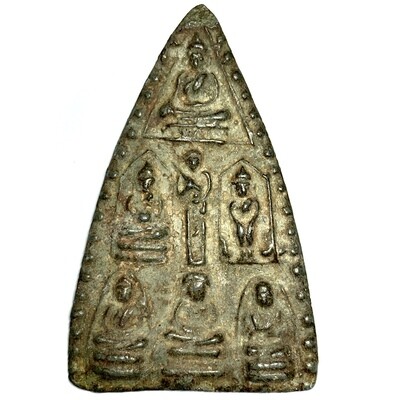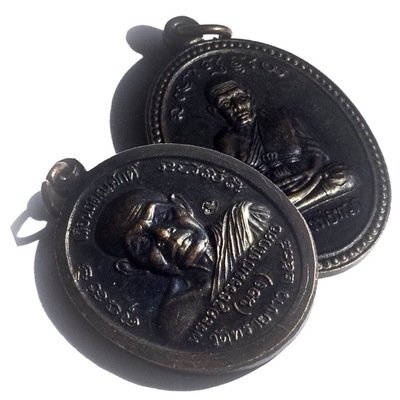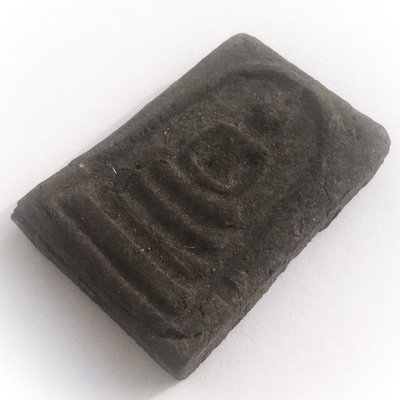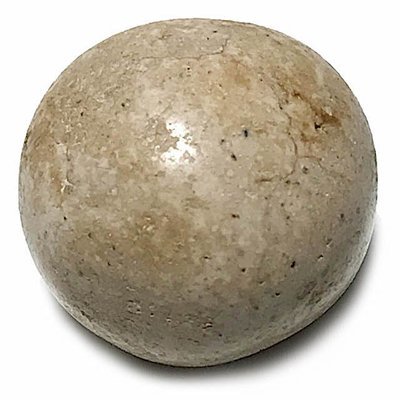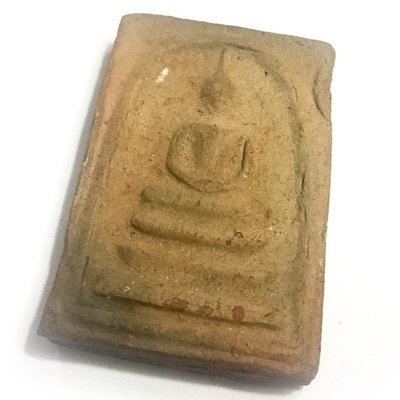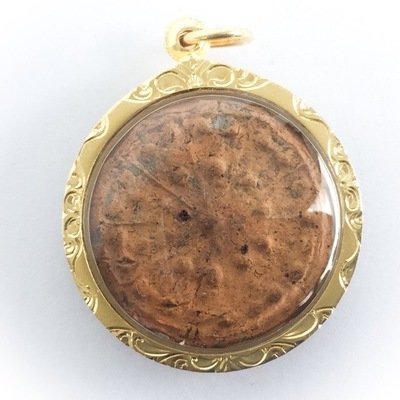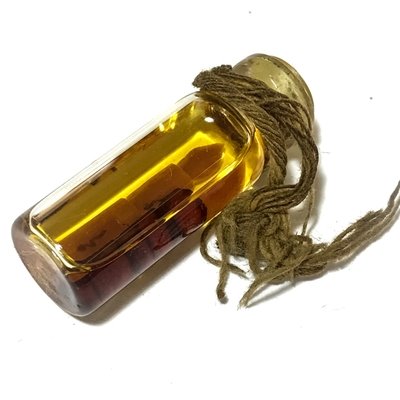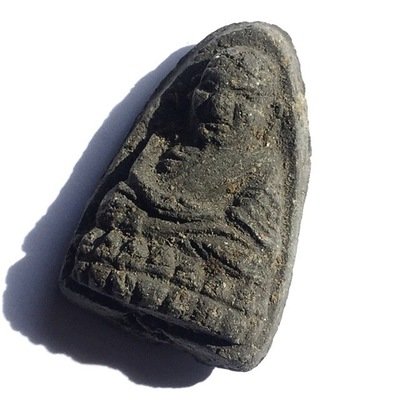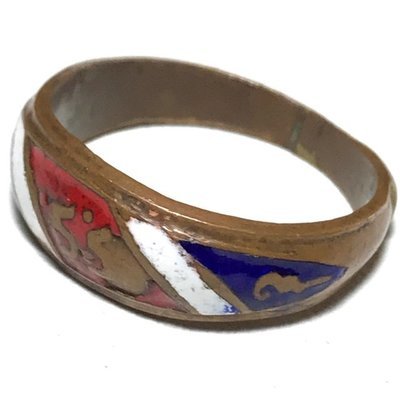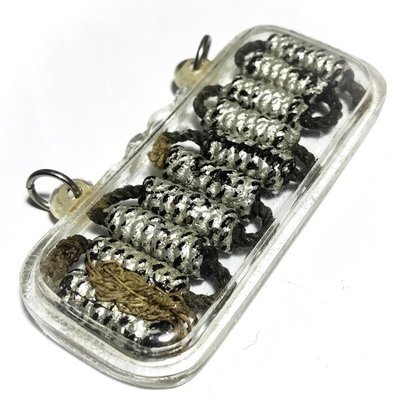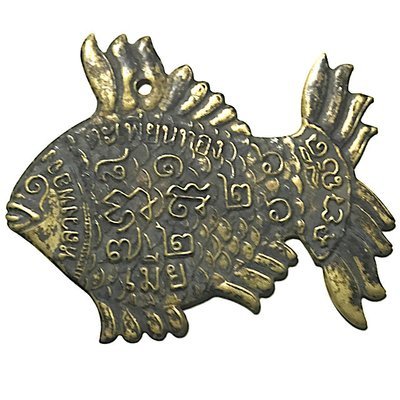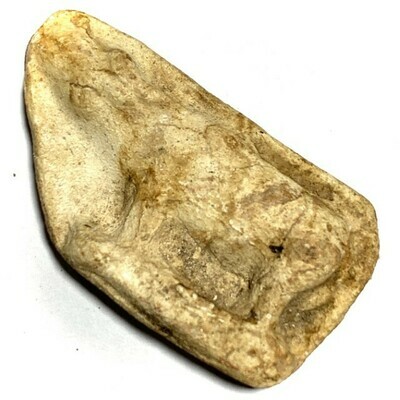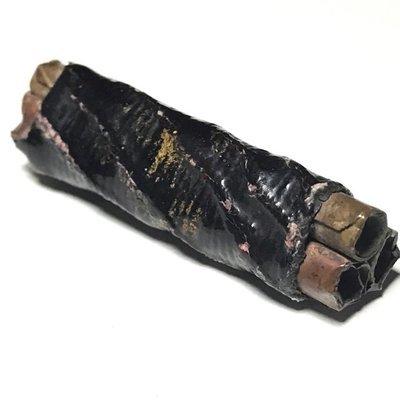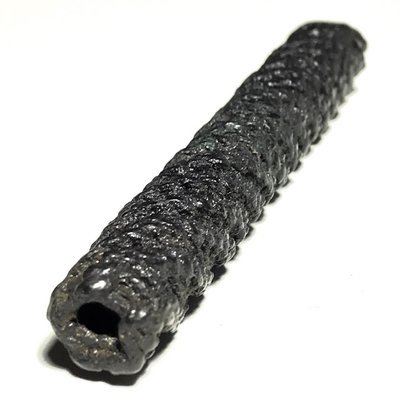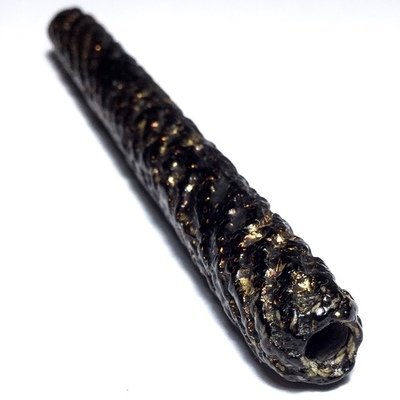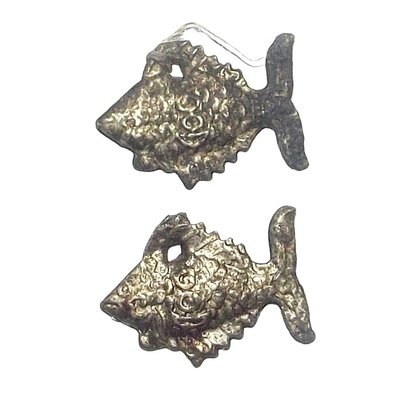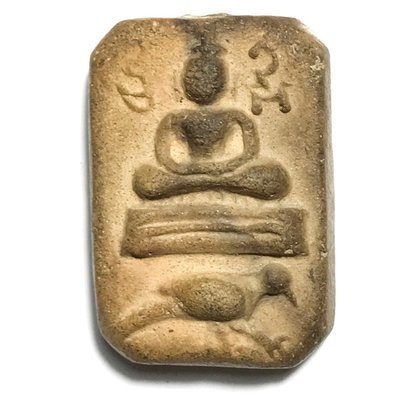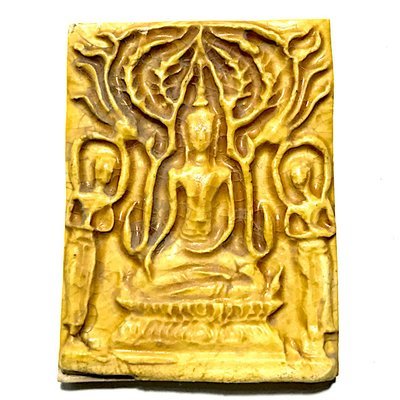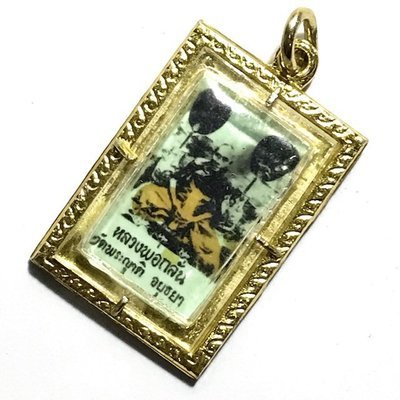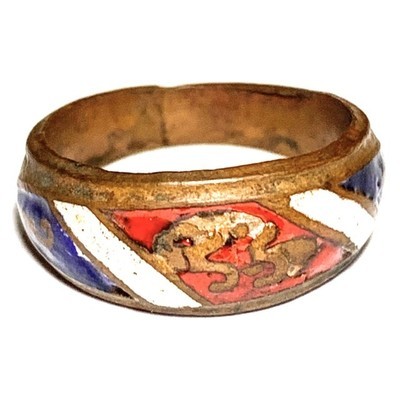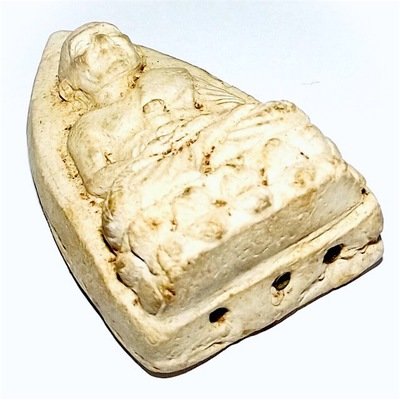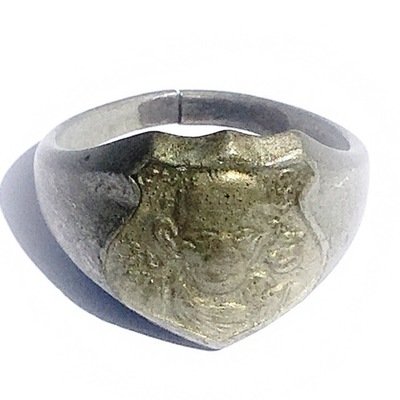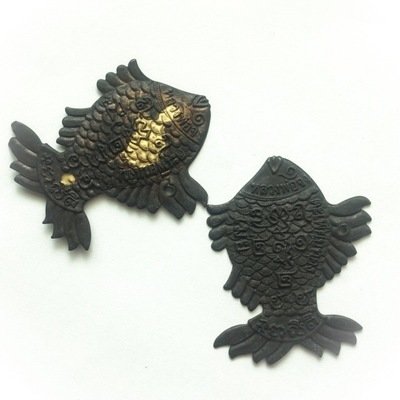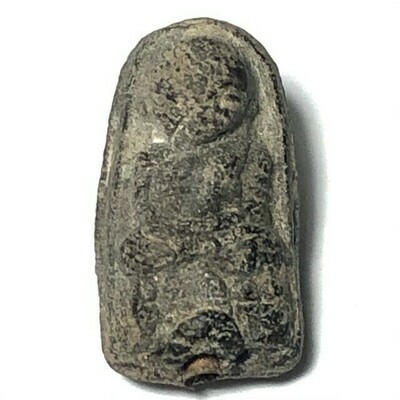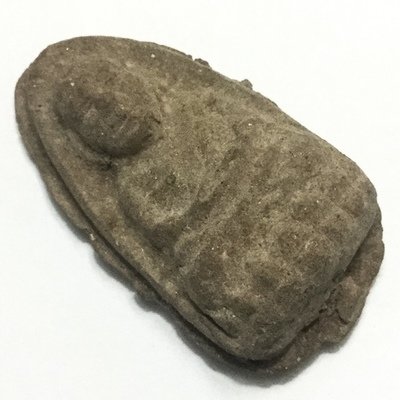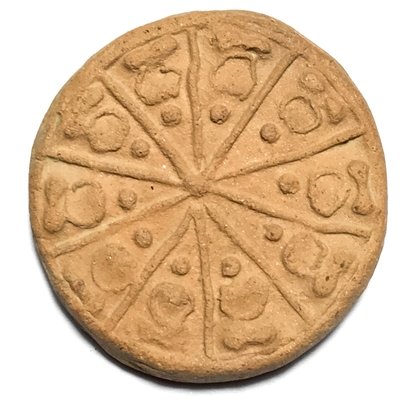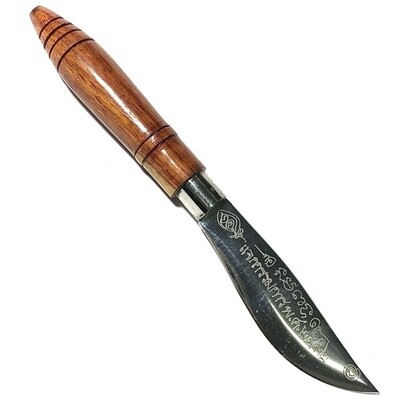Thai Buddhist amulets, or Phra Krueang (พระเครื่อง) in the Thai language, are sacred objects highly revered in Thai culture for their perceived spiritual and protective powers. Thai amulets and talismans, typically worn around the neck or carried on the person, are deeply embedded in Thailand’s religious, cultural, and historical landscape. They are intrinsically connected to the country’s Theravada Buddhist tradition and play a significant role in daily life, serving as both spiritual icons and symbols of faith.
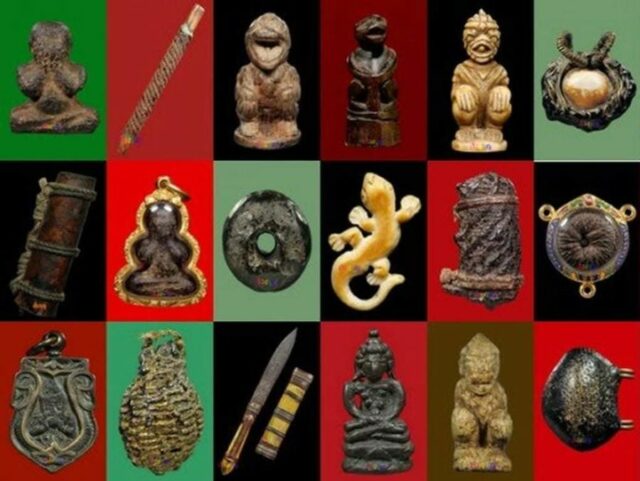
Historical Background
The tradition of wearing amulets in Thailand dates back centuries and is intertwined with the spread of Buddhism across Southeast Asia. Buddhist monks and devotees have long believed in the power of consecrated objects to offer protection, bring good fortune, and promote spiritual growth. Some of the earliest Thai amulets are thought to have originated during the Sukhothai (1238-1438) and Ayutthaya (1351-1767) periods, reflecting the influence of Indian and Khmer Buddhist art.
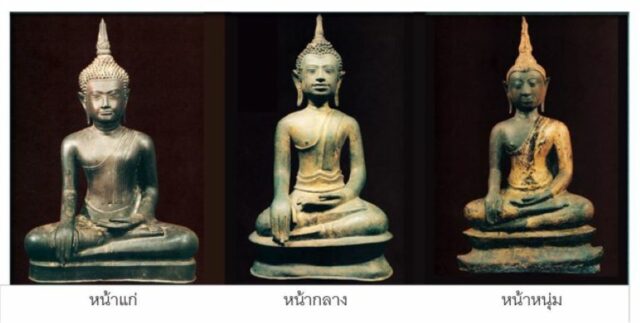
U Tong Buddhist Art
During the Ayutthaya period, amulets became popular not only among commoners but also among royalty and military figures. Kings and warriors were known to carry amulets into battle, believing in their ability to shield them from harm. These amulets were often made from materials such as clay, stone, or metals and were blessed by revered monks or in temple ceremonies, further enhancing their spiritual significance.
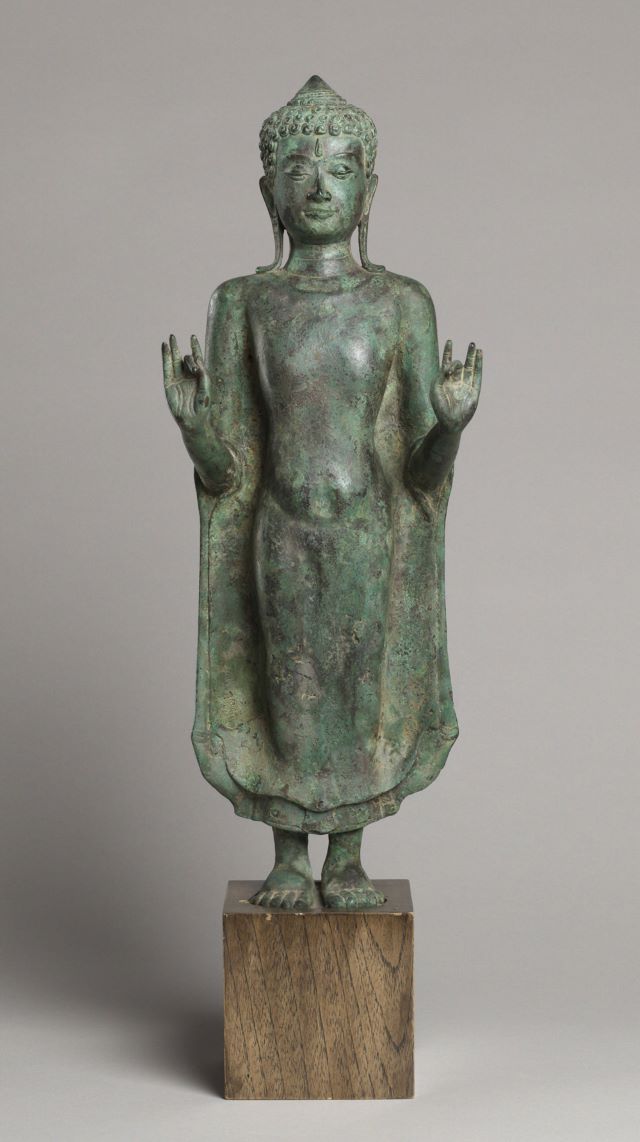
Dvaravadi Thai Buddha Forbidding the Ocean
The U-Thong era of Thai Buddhist art, named after the city of U-Thong in present-day Suphan Buri province, refers to a distinct period and style in the history of Thai Buddhist art that flourished during the 13th to 15th centuries. The U-Thong style emerged as a result of the convergence of various artistic influences, particularly those from the Dvaravati, Khmer, and Sukhothai periods. This era is considered significant in the development of Thai Buddhist sculpture and temple architecture, especially for its unique depictions of the Buddha and the evolution of Buddhist iconography in Thailand.
Historical;
The U-Thong era is believed to have developed concurrently with the rise of the Kingdom of Ayutthaya (1351-1767), although its artistic roots can be traced back to earlier periods, particularly the Dvaravati and Khmer civilizations. The city of U-Thong was an important trade and cultural hub, and this facilitated the fusion of various regional and external artistic traditions. As Ayutthaya expanded its influence over neighboring regions, including the former Khmer Empire and Sukhothai, it absorbed various artistic and cultural elements from these regions, contributing to the synthesis of the U-Thong style. This period is seen as a transitional phase in Thai art history, as it helped bridge the gap between earlier Buddhist traditions and the later, more distinct Ayutthaya style.
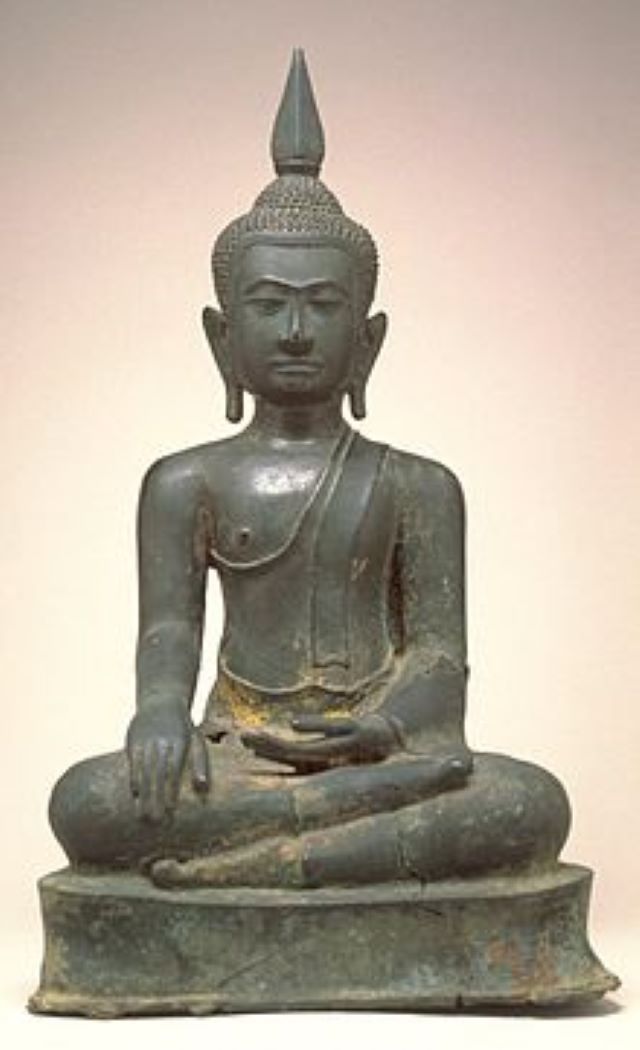
Pra U Tong Buddha Statue
Characteristics of U-Thong Buddhist Art
- Buddha Images: The U-Thong era is best known for its Buddha images, which exhibit a blend of Indian, Khmer, and Dvaravati influences. These sculptures are typically cast in bronze, although some stone and stucco images also exist. U-Thong Buddha statues are characterized by:
- Square face: Buddha statues from this era often feature a broad, square-shaped face, with prominent, arched eyebrows and a downward gaze, evoking a sense of calm and introspection.
- Hair and ushnisha: The Buddha’s hair is depicted as tightly curled, often with small, distinct curls. The ushnisha (a protuberance on the top of the head representing wisdom) is usually low and smooth, contrasting with the tall ushnishas seen in later periods like Sukhothai.
- Facial expression: The facial expression is serene, with the eyes half-closed, reflecting deep meditation. The lips are often thin and slightly curved into a subtle smile, embodying the Buddha’s compassion and enlightenment.
- Body proportions: The body of U-Thong Buddha images tends to be stocky and solid, with broad shoulders and a thick torso, which gives a sense of stability and strength.
- Hand gestures (Mudras): U-Thong Buddha images typically depict common hand gestures such as the Bhumisparsha Mudra (touching the earth), symbolizing the Buddha’s moment of enlightenment, or the Abhaya Mudra (fearlessness), signifying protection and reassurance.
- Robes and Drapery: The depiction of the Buddha’s robe in U-Thong art is distinctive. The robe clings closely to the body, with clearly defined lines, giving the figures a sense of gravity and formality. Unlike the Sukhothai style, which often features a transparent, clinging robe, the U-Thong style tends to depict a more structured robe, often covering both shoulders or with one shoulder exposed, depending on the regional variation.
- Influences: The U-Thong style is a synthesis of different artistic traditions:
- Dvaravati: The influence of the earlier Dvaravati period can be seen in the roundness and solidity of the Buddha figures. Dvaravati, an ancient Mon civilization, had already established Buddhist iconography in central Thailand, and its influence continued into the U-Thong era.
- Khmer: Khmer art, especially from the Angkor period, influenced the form and decoration of U-Thong sculptures, particularly in the intricacies of facial features and body proportions.
- Sukhothai: Although U-Thong art predates the full flowering of the Sukhothai style, it overlaps in time, and there are occasional stylistic borrowings. However, the U-Thong Buddha is generally more rigid and formal compared to the fluid grace of the Sukhothai Buddha images.
The Dvaravati era of Thai Buddhist art refers to the artistic and cultural developments during the Dvaravati period, which lasted from approximately the 6th to the 11th century CE. The Dvaravati culture, believed to have been Mon in origin, emerged in the central region of present-day Thailand and was one of the earliest civilizations to establish Buddhism, particularly Theravada Buddhism, in the region. This era is recognized for its significant contributions to the early formation of Thai Buddhist art and religious architecture, laying the foundation for later Thai artistic developments in periods such as Sukhothai and Ayutthaya.
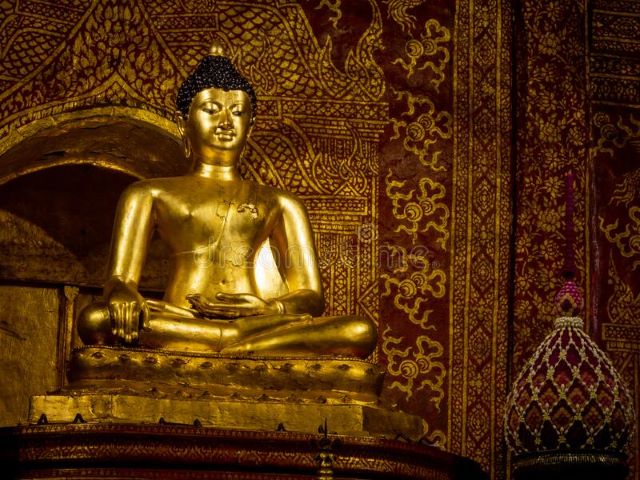
Wat Phra Singh Temple Chiang Saen Era style Thai Buddhist Art form
Historically speaking, Dvaravati was not a unified kingdom in the strict sense, but rather a series of city-states and principalities in the Chao Phraya River basin. These city-states were heavily influenced by Indian culture, which had spread across Southeast Asia through trade, religious missions, and political exchanges. The Mon people, who were instrumental in the development of Dvaravati, adopted Buddhism as their primary religion, particularly Theravada Buddhism, though Mahayana Buddhism and Brahmanism also had an impact on the region.
The Dvaravati culture is known primarily through archaeological remains, inscriptions, and religious monuments, many of which depict early forms of Buddhist iconography. The art produced during this era reflects the syncretism of Indian religious and artistic traditions with local Southeast Asian elements, forming a unique style that is distinct from other regions in the region.
Characteristics of Dvaravati Buddhist Art
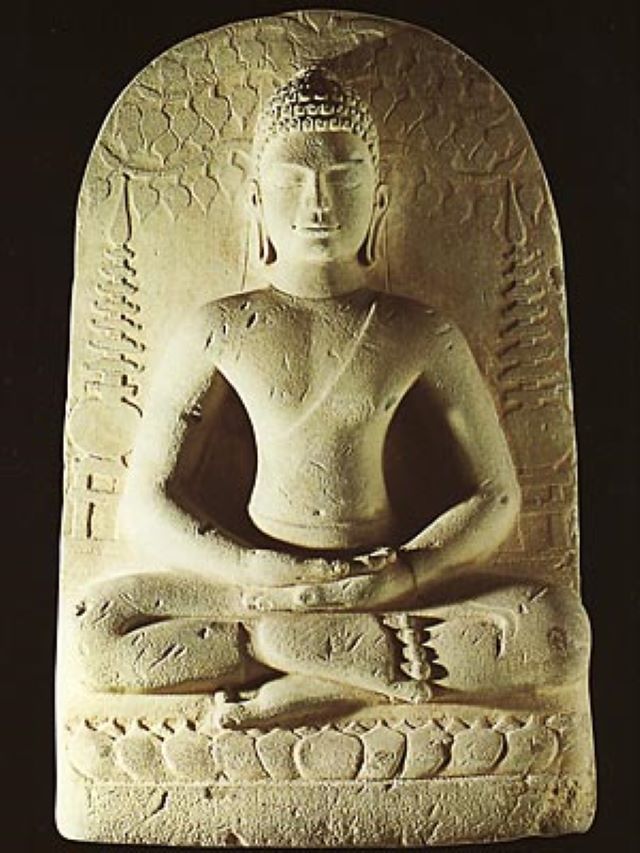
Tvaravadi Buddha in Maravijjaya Mudra
Buddha Images: Dvaravati Buddha images are among the earliest representations of Buddhist iconography in Thailand. These sculptures often show a heavy influence from Indian Gupta and Amaravati art, as well as early Pala art from Bengal. Key features of Dvaravati Buddha images include:
Facial features: The Dvaravati Buddha typically has a rounded face, with a serene expression, and large, almond-shaped eyes. The eyebrows are arched, and the nose is prominent but rounded. The facial expressions often exude calm and peacefulness, reflecting the meditative state of the Buddha.
Hair and ushnisha: The Buddha’s hair is usually depicted in small, tight curls, and the ushnisha (a cranial protuberance symbolizing the Buddha’s wisdom) is prominent but simple.
Body proportions: Early Dvaravati Buddha images tend to have heavy, stocky proportions, with broad shoulders and a thick torso, giving the figures a sense of solidity and permanence.
Hand gestures (Mudras): The Bhumisparsha Mudra (touching the earth) is commonly depicted in Dvaravati Buddha images, symbolizing the Buddha’s moment of enlightenment. Other common mudras include the Dhyana Mudra (meditation gesture) and the Abhaya Mudra (gesture of fearlessness).
Materials and Techniques: Most Dvaravati Buddha images are made of bronze, stucco, or stone. These materials were locally sourced, and the techniques used in their creation demonstrate a blend of local craftsmanship with Indian artistic traditions. Bronze casting was particularly advanced during this period, and many surviving examples of Dvaravati art showcase intricate detailing and a high level of technical skill.
Symbolism: Dvaravati art is deeply symbolic, reflecting core Buddhist principles such as the impermanence of life (anicca), suffering (dukkha), and non-self (anatta). These themes are subtly expressed through the serene and meditative postures of the Buddha figures, as well as in the religious narratives depicted in reliefs and stupas.
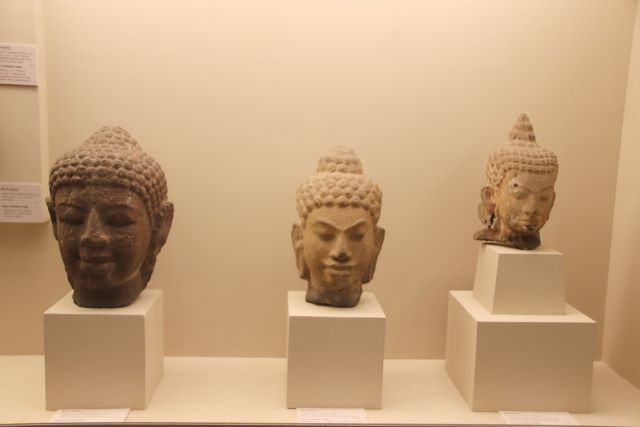
Tvaravadi Era Buddha Heads
Stupas and Religious Architecture
The Dvaravati era saw the construction of numerous stupas (Buddhist reliquary structures), which were central to the religious life of the period. These stupas served as places for devotion, housing sacred relics of the Buddha or important monks. Dvaravati stupas typically follow a simple design, with a hemispherical dome (anda) sitting on a square base, which was often elaborately decorated with carvings and reliefs.
Specific features of Dvaravati stupas:
Stupa Shape: The dome shape of Dvaravati stupas resembles early Indian models, reflecting the influence of Indian Buddhist architecture. However, local innovations were also evident, such as the addition of tiers and terraces surrounding the main stupa.
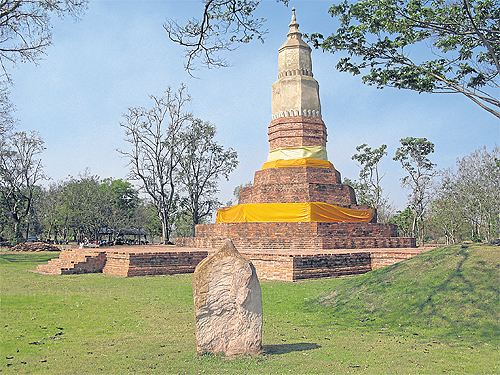
Phrathat Yakhu; Phrathat Yakhu represents the most significant site in Fa Daed Song Yang City.
Image source; https://www.bangkokpost.com/life/travel/345808/dvaravati-art-in-isan
Decorative Reliefs: Many stupas were decorated with narrative reliefs that depicted scenes from the Jataka tales (stories of the Buddha’s past lives) or events from the Buddha’s life. These reliefs were intricately carved into stucco or stone and showcased both religious and artistic significance.
Phra Pathom Chedi
One of the most famous Dvaravati stupas is the Phra Pathom Chedi in Nakhon Pathom, considered one of the oldest and largest stupas in Thailand. It has been rebuilt and renovated over the centuries, but its origins date back to the Dvaravati period. Phra Pathom Chedi, located in Nakhon Pathom, Thailand, is considered the world’s tallest stupa and holds great significance as it marks the site where Buddhism was first introduced to Thailand. Its name translates to “the first chedi,” symbolizing the beginning of the Buddhist faith in the region. The chedi serves as a major pilgrimage site for Buddhists and represents both historical and spiritual importance in Thai culture. It is recognized as the world’s tallest stupa, standing at 127 meters. Its construction dates back to the 19th century, initiated during the reign of King Mongkut (Rama IV) in 1853. The chedi was built to commemorate the introduction of Buddhism to Thailand and to restore the ancient stupa that existed on the site.
The construction involved traditional methods and local materials, primarily bricks and mortar. The design reflects a blend of Indian and Thai architectural styles, with a large circular base and a tapering dome. The project was overseen by various architects and craftsmen, including the famous Italian architect, who contributed to its grandeur. In 1870, after 17 years of construction, Phra Pathom Chedi was completed and consecrated. It serves not only as a religious site but also as a symbol of Thai cultural heritage and the historical significance of Buddhism in the region. Today, it attracts numerous visitors and pilgrims from around the world.
Narrative Reliefs and Decorative Art
In addition to Buddha images and stupas, the Dvaravati period is known for its decorative art, especially its narrative reliefs. These reliefs, often found on the walls of stupas and temple structures, depict key events from the Buddha’s life, such as his birth, enlightenment, and the first sermon at Sarnath.
One unique aspect of Dvaravati reliefs is the depiction of the Buddha using symbolic forms. In early Indian and Dvaravati art, it was common to represent the Buddha not in human form, but through symbols such as the Bodhi tree (symbolizing enlightenment), the footprint (symbolizing the Buddha’s presence on Earth), or the wheel (representing the Dhamma or Buddha’s teachings). Over time, these symbolic representations gave way to more anthropomorphic depictions, though they remained an important part of Dvaravati artistic tradition.
In addition to Buddhist themes, the Dvaravati period also produced reliefs and carvings that reflected Brahmanical (Hindu) influence, depicting Hindu deities such as Vishnu and Shiva. This highlights the religious syncretism of the period, with Brahmanism and Mahayana Buddhism coexisting alongside the dominant Theravada tradition.
Influence on Later Thai Art
The Dvaravati period laid the groundwork for much of the religious and artistic development in Thailand in subsequent centuries. The themes, techniques, and forms developed during the Dvaravati era were passed down to later periods, including the Sukhothai and Ayutthaya kingdoms.
For example, the Bhumisparsha Mudra, prominent in Dvaravati Buddha images, remained a key element in later Thai Buddha sculptures. The rounded, solid form of the Dvaravati Buddha also influenced the more graceful and refined images of the Buddha seen in the Sukhothai period, where a new emphasis on fluidity and elegance in religious art emerged.
The architectural styles of the Dvaravati period, especially in the design of stupas, also influenced later Thai Buddhist architecture. Many of the stupas and chedis constructed during the Sukhothai and Ayutthaya periods retained the tiered and terraced designs first seen in Dvaravati architecture, though these later structures became more elaborate and ornate.
Conclusion
The Dvaravati era is a pivotal period in the history of Thai Buddhist art, representing the earliest phase of Buddhist artistic expression in Thailand. It is marked by its synthesis of Indian and local traditions, creating a unique style that reflected the religious and cultural dynamics of the time. The art and architecture of this period not only served religious functions but also helped establish the foundational visual vocabulary of Thai Buddhist art for centuries to come.
Through its Buddha images, narrative reliefs, and religious architecture, the Dvaravati era made lasting contributions to the Buddhist artistic heritage of Thailand. Even today, the influence of this period can be seen in the religious practices, artistic traditions, and cultural identity of the Thai people.
U-Thong Temple Architecture
In addition to Buddha images, the U-Thong period also saw developments in temple architecture. U-Thong temples typically feature elements that reflect a combination of Dvaravati and Khmer styles. For instance, chedis (stupas) from this period are often square at the base with tapering forms, resembling early Khmer temples. Some of these structures were influenced by the classical Khmer design of prasats (sanctuaries) but were adapted to the specific Buddhist context of Thailand.
These temples were often decorated with stucco reliefs and Buddha images, many of which have survived to the present day. The architectural forms from this era laid the groundwork for the more complex and elaborate structures seen during the Ayutthaya period, which followed the U-Thong era.
Cultural and Religious Significance
The U-Thong period is a reflection of the eclectic nature of Thai art, which absorbed and integrated elements from different regions and periods into a uniquely Thai interpretation of Buddhist iconography. The Buddha images from this era were not just objects of worship but also served as cultural symbols representing the consolidation of Buddhist influence in Thailand, particularly during the rise of the Ayutthaya Kingdom.
In a religious context, U-Thong amulets and Buddha images were believed to provide protection and bring good fortune. Many of these artifacts were created as part of merit-making activities, with donors commissioning the creation of Buddha statues or the construction of temples to gain spiritual merit. Today, U-Thong Buddha images are still revered, and the style remains influential in Thai religious art, particularly in central Thailand. The U-Thong era, most definitely marks an important phase in the history of Thai Buddhist art, characterized by its synthesis of various artistic traditions and its contributions to the development of Buddhist iconography in Thailand. Its distinctive Buddha images, marked by square faces, serene expressions, and carefully detailed robes, remain among the most iconic representations of Buddhist art in Southeast Asia. The U-Thong style laid the foundation for the later artistic developments of the Ayutthaya period, continuing to influence Thai Buddhist art well into the future.
Types and Symbolism
Thai Buddhist amulets come in various forms and serve different purposes, with their materials, design, and associated rituals contributing to their individual power and significance. Broadly, these amulets can be categorized into the most famous of all-time types:
- Phra Somdej (พระสมเด็จ): Perhaps the most famous and highly revered type of amulet, Phra Somdej was created by the monk Somdej Phra Buddhachan Toh during the 19th century. It is often considered the “King of Amulets” and is known for bringing safety, good fortune, and spiritual advancement to its bearer. These amulets are typically made of sacred powder mixtures, including relics, herbs, and other consecrated materials.
- Phra Pidta (พระปิดตา): This amulet depicts a figure covering its eyes, symbolizing the renunciation of worldly desires and distractions. The wearer of this amulet is believed to receive protection from evil forces and misfortune, while simultaneously deepening their spiritual awareness.
- Phra Khun Phaen (พระขุนแผน): Named after a legendary warrior and folk hero, Phra Khun Phaen is associated with charm, attraction, and personal magnetism. It is often worn by individuals seeking to enhance their charisma, success in relationships, or business dealings.
- Phra Nang Phaya (พระนางพญา): Often referred to as the “Queen of Amulets,” Phra Nang Phaya is linked with female empowerment and is believed to provide its wearer with grace, beauty, and leadership qualities. This amulet is particularly popular among women.
- Luang Phor Thuad (หลวงปู่ทวด): An amulet dedicated to the legendary monk Luang Phor Thuad, who lived in the 16th century and is revered for his miraculous deeds. These amulets are believed to offer protection from physical danger and accidents, making them especially popular among travelers and those seeking physical safety.
Each of these amulets is believed to possess specific powers, which may include protection from danger, enhancement of personal charisma, promotion of health, prosperity, or spiritual development. The efficacy of these amulets is often tied to the intentions and blessings of the monk or temple that creates them.
Creation and Consecration
The process of creating a Thai Buddhist amulet is steeped in religious ritual and tradition. Amulets are usually crafted from a variety of materials, such as clay, bronze, silver, or even wood. Some amulets are made using special powders that include relics of deceased monks, crushed herbs, or soil from sacred sites. The choice of materials is significant, as they are often believed to enhance the spiritual potency of the amulet.
The creation of an amulet typically involves chanting sacred mantras, and once the amulet is complete, it undergoes a consecration ceremony known as phutthaphisek. During this ritual, monks will invoke the protective powers of the Buddha, as well as other revered figures, to imbue the amulet with spiritual energy. The length and intensity of these rituals vary depending on the amulet and the temple, but they are always conducted with utmost reverence.
Amulets blessed by highly respected monks, or those made in temples with historical significance, are considered to be the most potent. As a result, they are highly sought after by collectors and devotees alike.
Role in Society
Thai Buddhist amulets hold a unique position in Thai society. They are not merely religious objects but also cultural artifacts that reflect the deep-rooted Buddhist faith of the Thai people. Many Thais wear amulets daily, believing that they offer protection from accidents, illness, and misfortune. Soldiers, police officers, and business people are among the most prominent wearers, as they seek both physical safety and professional success.
Amulets are also a form of charitable giving and merit-making in Thai culture. Monks often distribute amulets to devotees in exchange for donations to the temple, with the proceeds going toward the upkeep of the temple, charitable activities, or community projects. This exchange strengthens the bond between laypeople and the monastic community, reinforcing the central Buddhist concept of dana (generosity).
Amulets as Collectibles
In addition to their religious and cultural significance, Thai Buddhist amulets have become valuable collectibles. Amulet trading is a thriving market in Thailand, with some amulets fetching high prices due to their rarity, the reputation of the monk who created them, or the historical period in which they were made. Amulet fairs and shops are common throughout Thailand, and collectors often spend years seeking out rare or highly revered pieces.
Despite the commercialization of amulets, their spiritual essence remains central to their significance. Collectors and devotees alike believe that the true value of an amulet lies not in its monetary worth but in the spiritual protection and guidance it provides.
Thai Buddhist amulets have, and still do serve as both sacred objects of devotion, and cultural symbols that reflect Thailand’s rich religious heritage. Their importance in Thai society cannot be overstated, as they bridge the spiritual and material worlds, offering comfort, protection, and a tangible connection to the teachings of the Buddha. Whether worn for personal safety, spiritual advancement, or as collectibles, these amulets embody the enduring faith of the Thai people and the profound influence of Theravada Buddhism on their daily lives.
Pra Putta Jao Pratap Sadtw 2460 BE Pim Khee Paya Krut Niyom Buddha Riding Garuda Luang Por Parn Wat Bang Nom Kho
Pra Putta Jao Pratap Sadtw - Pim Song Khee Krut Pim Niyom Yuk Dton, from the Great World Famous Master Monk, Luang Por Parn Sunanto, of Wat Bang Nom Kho (Amper Sena, Ayuttaya). Although official documentation categorizes all of these amulets as 2460 BE, in truth, Luang Por Parn released these famous magical amulets during many years of his life trajectory as a Master Monk, and hence, due to the exhibit having a very aged appearance, one would consider it 'early era', and probably made before 2460 BE. However, the block press mold reveals it to be of the 2460 BE series, but the age of the clay declares itself to be older, and hence could and probably is, an early era model. This is deducable, because, this block press mold, may, or may not have been created long before the 2460 series, and used along with other block presses. Therefore it is important to study the natural age of the sacred clay, more than the block press mold, in order to deduce which era the amulet came from. This hence demonstrates to the student, that there are many factors to consider, when deciding upon the era of an amulet.
The Buddha riding Garuda amulet of Luang Por Parn, was released in six different 'Pim' (at least those which are accepted as Pra Niyom preferred category amulets). They are found in various colored clays ranging from beige, brown, yellowish-white, reddish brown and terracotta red, as well as dark gray/blackish color.
This amulet is a historic Master Class amulet of immortal fame, and we highly recommend that this amulet should be encased with a form of casing that is worthy and deserving of its eminent status, namely solid silver or gold. Please select the encasement options according to your personal taste and desire.
Below, the special Pong Muan Sarn Yant Grao Paetch with Pong Wised inserted into the cavity of the upper border of the amulet.
There were six different kinds of Animals in the Dtamra of the 'Pra Putta Jao Pratap Sadtw' series of amulets made by Luang Por Parn, which he made after miraculous encounter with the Chee Ba Khaw Apparition who taught him this Wicha. In truth, these 6 models are found in up to 88 different styles, which is a lesser known fact. It is said in Legend, that if you pray to the amulet and chant the Kata of Luang Por Parn for 3 Years, that the Animal will come to life and leave the amulet.
The six different Pim are recognizable through their individual characteristics, the one in this image being the 'Thaan Bua Chan Diaw', which means 'single tier Lotus Dais'
There are some other Garuda and other animal models (all Pim Niyom preferred), but which do not have the petals of the lotus, rather, have single thin curved lines or straight line Dais, such as this Pim Khee Krut Niyom.
Its marks of authenticity, apart from knowing how to recognise the ingredients of the Sacred Powders and Muan Sarn in the amulet, and the signs of aging, are various;
1. The curved lines of the dais rise up to form the Khom 'Unalome' (Letter 'U'), in a circular shape around the Buddha, whose knees have aura-like thin lines
2. There is a small curved dome under the legs of the Buddha, and above the curved Unalome dais that frames him.
3. To our right side of the Garuda's wings (left wing from Garuda's point of view), a small thin line is seen rising up to connect with the border edge of the amulet.
4. The Khom Sanskrit Letter 'A', above the Buddha's left shoulder, is embossed Backwards, and has to be read in reverse.
5. The Khom Sanskrit Letter 'MA', above the Buddha's right shoulder, is also embossed Backwards, and has to be read in reverse. On this side of the Buddha, the Unalome Dais is also a Backwards letter 'U', reflecting its counterpart twin on the other side of the Buddha image.
6. The Muan Sarn Sacred Powder clay shows all the typical aspects and surface sheen, authentic Muan Sarn Sacred Powder content, and natural aging characteristics, which are highly evident to the naked eye.
7. The Pong Wised Muan Sarn Sacred Powders stuffed into the top cavity are so hardened with age as to be hard as concrete,due to over a century of aging in natural atmospheric conditions. This natural uneven petrification and hardening, and contraction of the Pong Wised Muan Sarn Sacred Powders is impossible to fake, and is a true revelatory characteristic of authenticity in an amulet
8. The angled oblong corners of the amulet show true contraction and age that can only arise through the natural passage of time, and natural hardening and drying, and contractions through passage of long periods of time.
This particular model is in a classic Terracotta colored clay and possesses all the classic features of the 'Dtamni' (Athentication Marks) for classifying itself as a true prefferred class of Pim Niyom Amulet by Luang Por Parn, and is hence possible for entry into competition with confidence of a prize. These days, few people can find themselves honored to have the chance fo encounter such an amulet to possess for their own collection, for which reason this amulet needs no explanation as to why this is a most desirable acquisition to have in one's personal museum collection, and even more so, to be able to wear it and be under its protective influence and receive its blessings.
A truly world famous classic amulet of the highest class and category, which anybody from the poor man to the millionaire will wear with pride and confidence of its magical powers. Who indeed does not wish to have a Luang Por Parn Wat bang Nom Kho Buddha Amulet on their pendant chain around their neck? We would say that there is not a single amulet lover on the Planet who would not wish to wear such a sacred Ancient Amulet as this.
Biography of Luang Por Parn
Luang Por Parn Sunantoe's real Ordained Monk name was Pra Kroo Wiharagijjanugarn. He was born in 1875 (BE 2418.) , the youngest son of Mr. Aaj and Mrs. Im Sutawongs. During his younger age, he received the a nickname of " Parn " , because of a red Birthmark on the little finger of his left hand, which was seen as an unusual trait mark that linked with Buddhism.
Luang Por Parn received his Ordination as a Bikkhu (Buddhist Monk) on the First of April 1895 (BE 2438).
Luang Por Parn is worshiped as one of the Top 10 Greatest Guru Monks of present-day in Thailand & many worshippers all around the world. He was the closest disciple of Luang Por Niam Wat Noi, Suphanburi, and also a disciple of Luang Por Hnoeng, of Wat Klong Madarn. His two great teachers passed away with their bodies un-decayed.

Above; Luang Por Niam, Wat Noi.
When Luang Por Parn passed away in B.E.2480, his body was also un-decayed similar to his Guru teachers.

Above; Luang Por Hnoeng of Wat Klong Madan
In 1932, five years before he passed away, he announced to all his disciples the date and time of his death. His precognition was quite clear and exactly correct; he passed away on the date and time he had preannounced. Luang Por Parn was a meditative Guru Monk and also possessed magical knowledge. During Buddhist Dhamma, it was recorded that he reached the “ Great six knowledge of miracles ”. So he possesses knowledge on precognition, out-of-body ability, mind detecting, ability to do comprehensive paranormal phenomenal feats of magical prowess.

He was of course famous for the Wicha of the Yant Grao Paetch Diamond Armour Yantra Spell, and for the Kata which many International Devotees have come to know as the 'Rich Kata'. It is said that this Kata can make you immensely wealthy as a Millionaire if chanted constantly and regularly without fail.
The legends of the powers of his Yant Grao Paetch spell are known by devotees around the world to be perhaps the most powerful Invincibility Spell of all, as well as providing an extensive set of Buddhist Blessings for Luck, Karma Improvement, Prosperity, Protection against all Ailments and Dangers, and of course for Wealthy Fortunes.

Apart from this, he also possessed the highest state of “ Vipassana ” or knowledge of mind cleaning to stop next rebirth (Reincarnation). It was his great Dhamma practice that had cleaned and " distilled " his inner body (astral body) to crystal-like state which changed his body's cells immortal. Many great Guru Monks in Thailand hinted their Dhamma levels to their disciples in such way.
Luang Por Parn's famous amulets have marked long-time uncountable records in warding off dangers of all kinds. And it's great for making holy water for healing illness that modern physician not able to diagnose & cure. Luang Por Parn'samulets are extremely unique withBuddha sitting on a Garuda, Hanuman, Porcupine, Fish, Cockerel, and Bird.
Once Luang Por Parn told his disciples that his amulets had been blessed for a period of three months, it's long time more than enough to charge Buddha's power into amulets capable of warding off dangers of all kinds. He said that if they were blessed for 3 years, the Garuda and the Bird on the amulet would fly out. (A real life news reporting of bird image flew out from the amulet was published in a Malaysia Chinese newspaper; A shop’s CCTV of the amulet’s owner recorded the “ flying bird ” flying around his shop and flew back into the drawer where the amulet was kept.)
Luang Por Parn's amulets are very popular among Thai amulets users and collectors because of their frequent miraculous phenomena both recorded and unrecorded. After his Ordination, Luang Por Parnstayed at Wat Bang Pla Hmor to study Gammatan and Vipassana, along with various Buddha Magic methods under the Supervision of L.P. Sun; Specializing in the topics of curing illness, physical aches and pains, and also curing people who were under the bad influence of black magic &harmful spells.He attained the level of " Adept " extremely quickly.
He also spent 2 years studying " Bariyadti Dhamma " , and Pali Sanskrit language under the Supervision of"Ajarn Jeen", from Wat Jao Jed; then continued his studies at Wat Sragaed in Bangkok, until his completion in " Apitamm " (Abhidharma) 5 years later.
When in Bangkok, Luang Por Parn recieved extra training in Traditional Buddhist Medicine at Wat Sangwaes. Luang Por also recieved training in Gammatan from Luang Por Niyam of Wat Noy in Ampher Basng Pla Ma, Supannburi Province, for a period of three months. In addition, he was trained an extra month by LP Hnoeng, of Wat Klong Madan in Ampher Sorng Pi Norng, Supannburi.
While in the forest, LP Parn received the secrets of creating Clay magical Amulets, in the form of a set of six different images from " CHI BA KHAW " . These 6 Amulets are the set of six Clay Buddha Amulets that are so revered and hard to find these days; considered by Disciples of Wat bang Nom Kho to possess extremely powerful magic.
The Secret of " Yant Grao Paetch " , or " Diamond Armour/Diamonjd Shield Yantra " as it has come to be known in the English language, was obtained from " Ajarn jaeng " , a lay Practitioner and Master of Yant and Buddha magic.
After completion of his training, Luang Por Parn inaugurated the Pali Sanskrit and Dharma school at Wat Bang Nom Kho. Apart from this, he assisted in the building and development of up to forty Temples around Thailand, including the additional construction of Shrines for other Temples that were already in existence(known as Bote in Thailand).
He is considered to have had to have possessed Extremely Great Virtues to have been able to attain the creation/construction of such institutions and enable the growth of Buddhism and spreading of the dharma on such a massive scale.
After Completion of his studies under Luang Por Sun, he performed " Tudongk " (Wandering alone deep through the Jungle). He wandered as far as the frontier to Burma, and encountered various strange Phenomena during his journey. Those strange encounters became legends, which are enough to fill a large book in themself.
In fact, there is a 900 page book recounting the Tudong Tales of Luang Por Parn, which include stories of his looksit Luang Por Ruesi Ling Dam of Wat Ta Sung, who was of course the Lineage Magic Inheritor and First Apprentice to Luang Por Parn at Wat Bang Nom Kho.
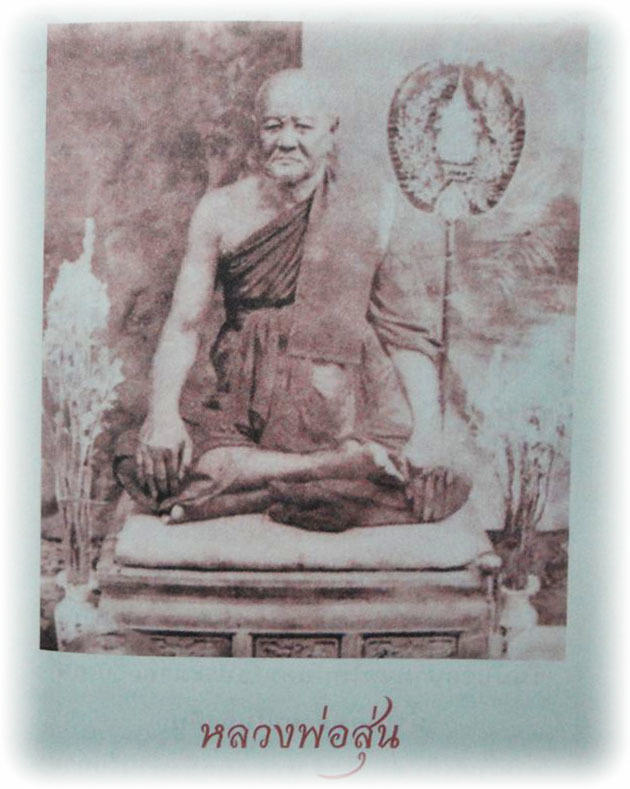
Above; Luang Por Sun of Wat Bang Pla Hmor
After his returning to Wat Bang Nom Kho, he performed Spiritual and Budhist medicinal healings for devotees who came with their problems. He treated the physical illness and also people under the in bad influence of Magical Spells and Curses. It is said that he who received treatment from Luang Por Parn was healed of his problem without any single exception !!!

Luang Por Parn had an extremely gentle appearance, with the Light complexion and aspect of a gentleman from the high society. His voice was soft, polite and pleasing to all ears. His mouth was always slightly curver upwards with a slight smile, and he possessed great compassion for both human and animals.
He didn’t separate social castes, receiving every visitor with the same compassionate and welcoming attitude, regardless of their social standing or ranking in the society. Social castes are irrelevant to him no matter one was a millionaire, a gentleman, royalty or a working class farmer or beggar. It is said that if a bad person, a thief, or drunkard paid a visit to Luang Por Parn, he would change his attitudes after visiting to Luang Por Parn, and became kinder, gentle and less wayward.
Luang Por Parn's daily routines when at Wat Bang Nom Kho; After the daily last meal at 11 am, he would rest a short while, after which, he would sit and receive visitors to help them with their requests. While waiting, he would prepare " Nam Mooh " (Prayer Water), for treating people with illnesses. There were an incredible number of people who came to see him in order to cure all sorts of illnesses, or were under the influence of Black Magic & Curses. Luang Por Parn treated people into the late hours, no matter how tired he might be. Even though he is no longer with us, he has given Buddhist people and those who believe in his ultimate powers an inheritance of the Body, Soul, Mind & also Fortunes. Luang Por Parn was well known for his Buddha Magic and Buddhist medicine & healing methods. He created powerful amulets during the Buddhist year BE 2460 (1917). He was famous for finding the extremely well known and powerful Katha/ Yant (mantra) of Grao Paetch (Diamond Armour )in the Buddhist year BE 2458 whilst making a pilgrimage to Suphanburi province. Famous for his discovery of the Sacred Yant Grao Paetch Diamond Armour Yantra.
LP Parn was very filial to his Mother and Father, who he cared for in their old age and times of illness. Even though LP Parn was abbot of Wat Bang Nom Kho temple. He brought them to the Temple and allowed them to stay in his Guthi, taking care and feeding them, and often wash his mother's clothing, regardless of his High status and amount of work he had to perform, he always make up time to take care his Parent.
In Buddhist teachings, one's Mother is seen as the most sacred person in Life, due to the pain she goes through in giving “Birth” to us, the worry when our young age and care she has for us as her children. When praying in Buddhist belief, the lighting of 5 incense sticks has the meaning of dedication : first three sticks to the Triple gem (Buddha Dharma and Sangha) , the fourth stick is to dedicate to one's Mother and father, the fifth to the Kru / Ajarn, meaning Teacher/Master.
After returning to his hometown, Ayuttaya , Luang Por Parn became the third abbot of Wat Bang Nom Kho, because he had reached a very high level of meditation and the people there respected him very much and showed confidence on him. Luang Por Parn returned to Wat Bang Nom Koh to teach the locals meditation and Buddha. He then rebuilt Wat Bang Nom Koh and turned it into a majestic temple.
Luang Por Parn also help to re-build as many as 41 others temples in Ayuttaya. In fact, Luang Por Parn had once met Ajahn Pon, an ordinary monk , and was curious to see him distributing money every day to different temples for sponsoring and helping to rebuilt temples everyday.
So Luang Por Parn asked him about his job and why he was so rich that he did not need to work ands went to temples everyday. Ajahn Pon replied that he had no job nut often chanted some incantations and this made him become rich.
In the beginning, Luang Por Parn was doubtful about Ajahn Pon's ability but as time went by, Ajahn Pon still donating to the temples. At last, Luang Por Parn believed Ajahn Pon's words and learned the incantations from him.
They possess magical effects and can bring wealth as well as giving protection. Later, Luang Por Parn became famous for these incantations. Luang Por Parn had once said that he would be able to concentrate chanting these incantation regardless of whether he was walking or sitting.
There was once a person asked Luang Por Parn what effects the incantations had. Luang Por Parn answered, that if he chanted the incantations sincerely, the scriptures would make him become richer: if farmers chanted the incantations, they would have a good harvest, the quality and quantity of the crop yield would be better as well as avoiding insect pests and disasters.
For business people, their products would be saleable and for employees , they would work smoothly, be promoted or enjoy salary increment. As long as they are sincere, then they will be rewarded. The following are the incidents which are quite well known among the locals. Luang Por Parn was a master that had many disciples. whenever Luang Por Parn needed money for temple used, his disciples from near and far would come to his aid.
Most of the money spent on renovations came from the sales of amulets as well as donations from his disciples. Beside building temples, Luang Por Parn also helped villagers treat their sickness and free them from the spell. luang Por Parn would use holy water and herbs mixed with Pali scriptures, and meditation power to help the villagers. All the people who went to him would have their problems or illnesses solved in the end.
